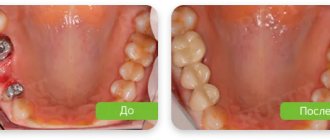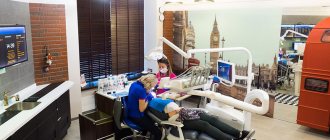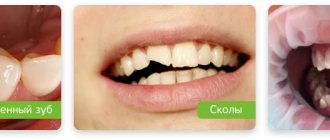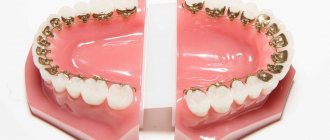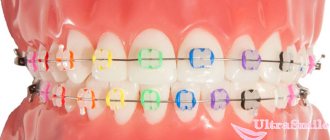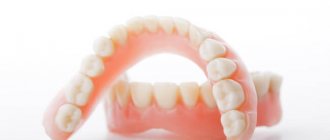Home » Braces systems » Choosing braces. Which systems are better to install?
Pathological bite today is considered one of the most common dental problems. This defect affects approximately 10% of the population. The danger is that such a violation not only causes a cosmetic defect on the face, but also leads to early tooth loss and the possibility of various diseases of the digestive tract. In this case, poorly ground food penetrates into the stomach cavity, which leads to the fact that the digestive organs receive a double load, associated with the need for additional processing of the incoming food substance. Over time, an inflammatory reaction begins in organ tissues.
The most suitable way to treat malocclusion is considered to be the installation of a special corrective structure (braces) on the teeth. It is fixed on the dentition, which is subject to alignment. With the help of braces, you can correct your bite at almost any age. It is most rational to do this in childhood, when the final ossification of the jaws has not yet occurred and it is much easier to move dental units in the required direction.
Modern orthodontics makes it possible to correct teeth in adult patients who did not undergo the treatment procedure at a young age. In addition, there are situations when dental disorder occurs precisely in adulthood:
- during the period of appearance of “wisdom” teeth, displacing the dental row;
- after resection of unhealthy dental units, when neighboring teeth move into the free space.
Orthodontic therapy in such cases is the optimal way to eliminate the anomaly that has arisen.
The questions “How do braces work?”, “Which ones are better to choose?” is of interest to every person who is faced with the problem of crooked teeth and wants to correct the defect. In short, the corrective effect is achieved through prolonged, precisely thought-out pressure on the teeth with orthodontic arches. Thanks to the targeted effect of traction, crooked teeth are gradually “stretched” in the right direction and take the correct position.
Any of the modern braces systems can correct the bite properly. But the variety of products offered makes us think about which of them has the most advantages and which one should be preferred in the treatment of a child, teenager and adult? All this will be discussed further.
How to choose braces?
Before making a difficult choice, you need to undergo a diagnosis from an experienced orthodontist. The specialist will analyze the condition of the oral cavity, the nature and severity of the defect, and potential ways to eliminate the anomaly. After this, the doctor will provide the patient with a detailed overview of braces, describing their types and the main features of each.
When choosing braces, the patient’s opinion must be taken into account. Important points are the aesthetics of the system, the duration of the therapeutic course, cost, etc. Taking into account all the “subtleties”, you can make the right choice - install a design that meets the client’s wishes and guarantees a high-quality therapy result.
Types and materials
Among the types of bracket systems that differ from each other in the material of manufacture, there are:
- metal;
- ceramic;
- plastic;
- sapphire;
- titanium;
- combined.
Braces also vary in location on the teeth:
- vestibular - external, do not affect the speaker’s diction;
- lingual - internal braces. During adaptation they can greatly influence diction.
Vestibular or lingual braces – which is better?
Vestibular structures are installed on the outer surface of the dentition, and lingual ones are attached to the inner surface. The first type of orthodontic products is clearly visible to others, while the second allows you to keep the therapy process a secret. Both types of systems have their own characteristics, which should be familiarized with before making a choice in favor of one of the options.
The vestibular brace system is installed on the outer surface of the dentition
The process of correcting malocclusion using a vestibular structure has the following positive qualities:
- relatively reasonable cost;
- absence of diction disorders and discomfort while wearing;
- shorter course of treatment.
The disadvantages include cosmetic imperfections. As mentioned above, the vestibular systems cannot be hidden from prying eyes; they are quite noticeable on the teeth.
The lingual brace system is attached from the inside
Features of lingual constructions :
- aesthetics, invisibility to others;
- the ability to constantly monitor movements in the dentition (the result can be observed in the mirror);
- high price;
- extended correction period;
- discomfort - change in speech, difficulty eating (these phenomena in most cases disappear after the adaptation period has passed).
In addition, there are certain contraindications to the installation of lingual systems.
Comparison of systems up close
The choice of the type of orthodontic structure depends on what exactly is the patient’s priority: a shortened course of treatment, price or aesthetics. If it is fundamentally important for a person that the treatment does not become public knowledge, then it is better to choose the lingual system. If you want to straighten your teeth as quickly and inexpensively as possible, then the vestibular type of device would be the best option.
Children usually have vestibular systems installed. This is due to the fact that such products cause less discomfort to the child and allow the defective bite to be eliminated more quickly.
Advice from orthodontists
Children
Children can only have braces after 12 years of age. The minimum threshold for installing braces on the entire dentition is 10 - 12 years. At this age, vestibular metal braces are usually used.
After the formation of the bones of the facial skeleton and the root system of the teeth is completed, that is, after 14 years, you can use any design of braces according to indications.
Adults
If the patient does not suffer from severe chronic diseases, orthodontic treatment is possible at any age.
But you need to be prepared for the following:
- treatment will last longer than in young people;
- some teeth will be asked to be removed;
- more pressure will be exerted on the teeth, so metal structures are more often recommended for adults;
- treatment will ultimately cost more than under the same clinical conditions, but at a younger age.
The choice of system depends on specific individual characteristics, the degree of deformation of the dentition and patient preferences.
Which braces to choose – ligature or non-ligature?
Depending on the design, there are two types of braces:
- ligature - arches are attached using elastics or wires;
- non-ligature – the arch is attached using a special orthodontic mechanism.
If you install ligature braces, then you will need to visit the doctor once a month to correct the installed device. This system is budget-friendly, but it requires more careful care, and the elastics are very “eye-catching” (teenagers often choose colored elastic bands, creating their own individual style).
The ligature-free system is very comfortable to wear. To correct it, you need to visit the orthodontist less often (about once every two months).
An alternative opinion on non-ligature constructions
Many professionals do not consider self-ligating braces to be the pinnacle of technology. Over time, orthodontic treatment is automated, so on average the quality of treatment is certainly improving. Previously, doctors themselves formed arches for patients, and those who did it better had more effective treatment. Now there is a choice of standard archwires formed by manufacturers, but for some reason the flow of people wishing to be treated by real professionals still exceeds their physical capabilities.
The first attempts to install self-ligating braces were made back in the 70s of the 20th century, and since then their design has been repeatedly revised and improved. But if manufacturers had really managed to achieve some kind of orthodontic perfection, then the luminaries of world orthodontics would have long ago abandoned the “antediluvian” ligature structures.
Which braces are the best in terms of material?
Braces are made from different materials. Depending on this indicator, systems are:
- Metal. Pros: reliability, functionality, efficiency, versatility, low price. The downside is cosmetic imperfection, because of which many patients do not decide to install such a product.
- Ceramic. Advantages: aesthetics, ease of use, durability. You can choose the color of medical porcelain to match the patient’s teeth or make the braces transparent.
- Sapphire. Pros: aesthetics, comfort to wear. Disadvantages: high price, relatively low strength, inability to correct serious malocclusion pathologies.
- Plastic. There is only one plus - cheapness, but there are many disadvantages: fragility, inconvenience, a high probability of staining with food pigments, etc. Experts advise choosing such products with caution.
The most popular products are metal (they shorten the course of treatment) and ceramic (they add aesthetics to the smile). In especially severe cases, malocclusion can only be corrected with the help of a metal system. Adult patients often choose systems made of precious metals - they look impressive and stylish, but are expensive. Children, as a rule, have traditional metal braces made of a safe alloy.
Metal braces
Metal structures are considered the most reliable. They effectively correct the bite and do not corrode. Wearing them does not cause discomfort in the oral cavity. At the same time, the systems are very affordable, and therefore have become most widespread among patients.
The advantages of such devices do not end there, as they:
- Not subject to deformation due to high strength
- Effective even when correcting very serious malocclusion pathologies
- Minimize discomfort during installation and wearing
- Even with the shortest treatment time they give the desired result
- Do not contribute to tooth enamel staining and do not change color until the end of treatment
However, all these advantages are hampered by some disadvantages inherent in metal structures: they do not look very aesthetically pleasing, they can cause an allergic reaction and they cannot be produced individually.
Rating of metal braces
Let's highlight several of the best, in our opinion, brands of bracket systems from trusted manufacturing companies:
- Damon. These braces minimize the treatment period and are a self-regulating system. They have a low degree of friction, an excellent sliding system, and comfortable locks. All these features have the best effect on the overall effect of treatment.
- Alexander. The systems are created from medical hypoallergenic steel, their installation is carried out without the use of ligatures. A special feature of these braces is their resistance to deformation due to their high degree of strength. The cost of structures ranges from 10,000 to 20,000 rubles.
- Ormco. These designs are classical ligature systems and have a slight thickness. All this contributes to their maximum wearing comfort. Systems can be made from an alloy with nickel or gold plating, or they can be created from durable titanium. Thanks to the design features, the best closure of the teeth is guaranteed. Even incomplete teething is not a contraindication to the installation of such braces. The price range is also impressive and depends on what material these systems are made of. If gold is used, the price of the devices will be very high - about 30,000 rubles, but titanium and nickel alloys will cost the buyer less - about 9,000 rubles.
Prices
Below are the average prices for bracket systems prevailing in Moscow for one jaw.
| System name | Price in rubles |
| Damon | 13 000 |
| DamonClear | 52 000 |
| Damon 3 | 14 000 |
| STB | 70 000 |
| Incognito | 200 000 |
| Forestadent | 40 000 |
| Alexander | 12 000 |
| Gemini | 40 000 |
| Clarity | 60 000 |
| Aspire Ice | 30 000 |
| Elan | 35 000 |
| In-Ovation L | 50 000 |
| Victory | 25 000 |
Prices may vary in other regions. Pricing is also affected by the status of the clinic, the qualifications of the doctor, and the dollar exchange rate. In addition, you will additionally need to pay:
- A complete diagnostic examination and preparation for treatment costs on average 80,000 rubles.
- Replacement of ligatures, every 2 - 3 weeks - 500 rubles.
- Replacement of arches, every 1 - 2 months - 3,000 rubles.
- Removing the device – 10,000 rubles.
- Installation of a repeater – 7,000 rubles.
Ceramic braces
In terms of aesthetics, few corrective systems can compare with models based on ceramics. A pleasant feature of these systems is that their color range is close to the natural color of tooth enamel, which makes the treatment process almost invisible to others.
In the process of creating devices, modern materials and special photopolymers are used. Thus, the consumer is guaranteed a high degree of convenience when using them.
The undoubted advantages of ceramic corrective systems include the least degree or complete absence of wearing discomfort, high strength, reliability of mini-locks, and hypoallergenicity. Another advantage is the durability of the original color, protection from injury to the soft tissues of the oral cavity, and the absence of psychological pressure when wearing them due to the highly aesthetic appearance.
The disadvantages of ceramic systems include an increased wear period, high cost, the possibility of demiralization of tooth enamel, and some discomfort when removing them.
Disadvantages of systems
Ligature braces have the following disadvantages:
- systems with metal ligatures are contraindicated for people with allergies to metals, oncology, epilepsy, or an implanted pacemaker;
- elastic fastening elements are subject to loss of elasticity, destruction and discoloration, and therefore must be replaced frequently;
- metal fixation parts can injure the tissues of the oral mucosa;
- hygienic care is difficult;
- the need for monthly system setup;
- impossibility of use for periodontal diseases.
Disadvantages of self-ligating systems:
- increased discomfort due to the large volume of the structure;
- relatively high cost.
Sapphire braces
Of all the existing types of braces, sapphire structures are the most transparent, and therefore it is not surprising that the systems are chosen by those patients who, due to their work, must always be visible. In terms of cost, these braces are more expensive than all other types , and significantly so.
Corrective plates attached to teeth are created using special microcrystalline sapphires. The use of sapphire braces is limited to correcting only minor malocclusions; serious cases of correction require the use of other systems. The advantages of such designs are obvious:
- They are almost completely invisible on the teeth
- Smooth polishing of the plates minimizes the likelihood of injury to the oral mucosa
- They do not change color while wearing them.
- Patients quickly get used to them, as the devices are comfortable to wear and do not cause discomfort.
- Guarantees a flawless smile
- Fits securely and is easy to remove
Speaking about the disadvantages, it is important to note that sapphire braces are an expensive pleasure, and the treatment period with such braces is very long. During the entire period of therapy, the patient must pay increased attention to oral hygiene, and the fragility of such braces forces them to be treated with particular care. In addition, if the patient has serious problems with his bite, he will have to refuse to use these braces.
Rating of sapphire braces
Sapphire braces are rightfully considered innovative. The most commonly used are the following models:
- Ormco (Inspire ICE). A company from the USA, quite well known in the market of orthodontic structures. Produces plates with flawless polishing.
- American Orthodontics (Radiance). The company's particularly durable plates are known all over the world. Removing and reinstalling these plates is a breeze, thanks in large part to the reinforced structure in the center and lighter edges.
- Ortho Technology (Pure). Aesthetic and incredibly neat. They are distinguished by the presence of a coating of zirconium dioxide powder, so they are easy to remove and reinstall.
If we compare prices for different types of wafers, sapphire wafers are considered the most expensive, which is not surprising, given all their advantages. Based on cost, the devices are divided into 2 categories, and the price from 90 to 120 thousand rubles belongs to the “economy” category. A more advanced “business option” will cost even more – at least 120 thousand rubles and up to 200 thousand, sometimes higher.
It is also worth noting that the above-mentioned cost includes not only the sapphire braces themselves, but also payment for all stages of treatment - polishing, installation and subsequent removal of structures, creation of a permanent retainer.
Leading manufacturers
Braces were first developed in the United States back in 1886. Over the years, the designs have been improved, shortcomings have been corrected, and now they have become convenient devices for correcting bites.
There are many companies producing orthodontic systems, but the most famous, producing products of the highest quality, are the American Ormco, GAC, 3M Unitek.
Ormco
The company began producing dental devices in the last century; their products receive only high marks from dentists and their patients.
A significant advantage of the company is the well-established work of the dealer network , which promptly ensures delivery of products even to distant regions of our country.
The prices of Ormco products are quite high, but the quality of the systems, according to specialists and patients, justifies the costs.
GAC
Dentsplay is the oldest company, producing dental products for more than a century. Dentsplay GAC is its subsidiary, which specializes in the development and production of orthodontic systems.
In the GAC division catalog you can find various modifications of structures made of metal, plastic and ceramics.
3MUnitek
The company has been supplying the market with orthodontic products since 1948. Among her developments is the use of durable stainless steel for the production of braces.
The company also produces self-ligating systems and staples, with a pre-applied adhesive composition on the surface, for quick and easy fastening.
Today, the company's catalog consists of several thousand items of products made using the latest technologies and methods.
Universal devices made of metal and ceramics are in great demand.
Plastic braces
These systems are considered a worthy alternative to metal structures, but, unlike the latter, they are characterized by an aesthetic appearance. Plastic braces are more similar to ceramic or sapphire structures than to metal systems.
It is quite simple to choose the color of plastic to match the enamel of the patient’s teeth. Plastic structures compare favorably with others due to their affordable cost, as well as wide possibilities in terms of color choice. The disadvantages include fragility, dietary restrictions (very strict requirements are imposed on the consumption of solid food) and a long correction period.
In addition, these braces often have to be changed, which does not have the best effect on the cost of treatment.
The best brands of plastic braces
Speaking about the rating, it is worth noting such brands as:
- Spirit Alexander. Made of transparent plastic and have a metal groove for the arc. These are the only aesthetic braces that have wings to correct rotations. The rotary wings are made of stainless steel, but when installing the braces system, they are hidden behind the wire arch, which allows you to maintain the aesthetics of the overall appearance of the braces. Spirit Alexander braces have rightfully gained well-deserved popularity among practicing orthodontists around the world. Comparable in aesthetic qualities to ceramic braces, plastic braces have a number of undeniable advantages: ease of installation, safety of removal from the enamel surface, adequate friction force.
- Spirit MB. Spirit MB plastic braces developed by ORMCO combine the excellent aesthetic characteristics and biomechanics of metal braces. Adhesion (sticking) to the enamel surface is achieved through mushroom-shaped undercuts on the base of the bracket, which create mechanical fixation comparable in reliability to metal braces. Spirit MB braces (Spirit) can be installed on any orthodontic adhesive. The use of a metal groove makes it possible to improve the sliding of the arc and more accurately implement the angular and torque characteristics inherent in the braces. It is not recommended for use on the lower jaw in cases of deep bite (braces can be worn out due to occlusal interference).
- Elegance. The amazing bonding characteristics of Elegance SL (Super Lock) provide excellent adhesion to tooth enamel. Features: Fiberglass reinforced composite, High break resistance, Computer generated design, Minimum size with maximum strength, Optimal sliding mechanism, Special metal slot design, One piece single groove and hook design, Maximum strength without cracking, Clear color marking system .
Braces - what are they and what are they for?
Braces are a permanent orthodontic device designed to correct malocclusion or unevenness of individual teeth. The system consists of clasps attached with dental glue to each tooth and a metal arch threaded through them. Along the edges of the dental row, the system is attached with rings to 6 or 7 teeth. The degree of tension in the arch allows the teeth to gradually move in the desired direction specified by the orthodontist. To ensure that the teeth move as they should, the doctor periodically monitors and adjusts the degree of arch tension. Different types of braces require different frequency of monitoring.
Braces are installed by an orthodontist after preliminary diagnosis and identification of the patient’s pathology.
Incorrectly selected or installed braces can lead to systemic disorders such as headaches, poor posture, decreased vision, and even cerebrovascular accidents.
It is very important to choose a dental clinic that has a positive experience in installing braces. You can do without negative side effects!
Braces allow you to straighten your teeth and correct your bite
Which braces system is best for an adult?
Preference should be given to the design that can make the treatment course as effective, convenient and at the same time affordable for a person. When choosing braces, an adult should focus on the following parameters:
- Price . The patient must decide how much he can spend on orthodontic therapy and choose a device within an acceptable price range.
- Aesthetics and duration of treatment . If for the patient aesthetics is at the top of the list of product requirements, then a lingual or ceramic transparent design is chosen. If a person is interested in shortening the treatment period, then he can opt for a vestibular system made of metal.
- Number of visits to the orthodontist . If you choose a ligature system, you will have to go to the doctor more often. In order to correct a non-ligated product, the orthodontist’s office is visited less frequently.
Based on these factors, the patient will decide which brace design he likes best. But it should be remembered that the final verdict is made by the doctor, who also takes into account the characteristics and severity of the dental defect and the personal characteristics of the client’s oral cavity. The correct choice of a corrective system is the key to successful treatment.
Choosing braces for children
The process of choosing an orthodontic system for a child has its own nuances. The young patient needs to be provided with psychophysical comfort. It is necessary to minimize, as far as possible, all potential inconveniences associated with the operation of the correction device. At the same time, the main goal remains the final result - rational and quick correction of the dental defect.
Braces suitable for children should:
- effectively correct dental anomalies;
- carry out corrective work in the shortest possible period of time;
- ensure ease of implementation of hygiene measures relating to the oral cavity;
- be durable, comfortable to wear;
- to look nice.
Considering these requirements, we can say that it is better for children to install vestibular braces made of metal. Of course, such products are inferior to ceramic ones in terms of aesthetics, but this drawback can be eliminated by installing bright ligatures and colorful elastics, which are very stylish and are liked by many teenagers.
